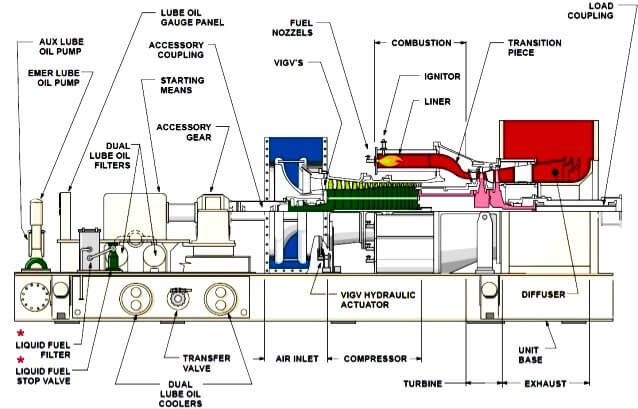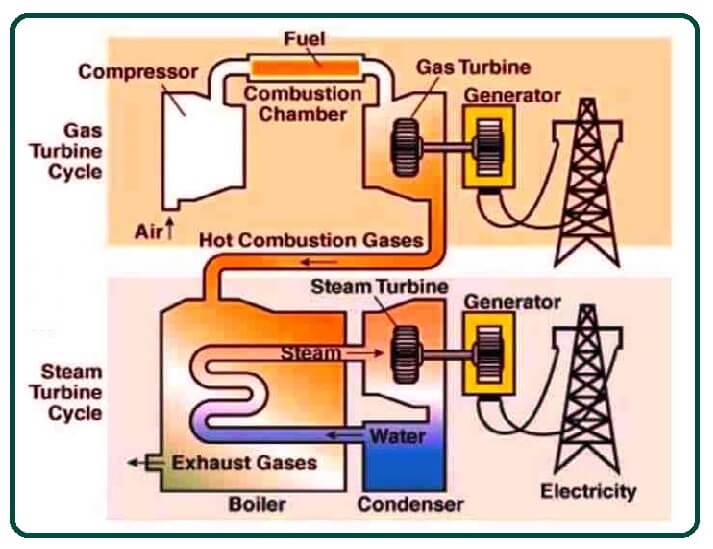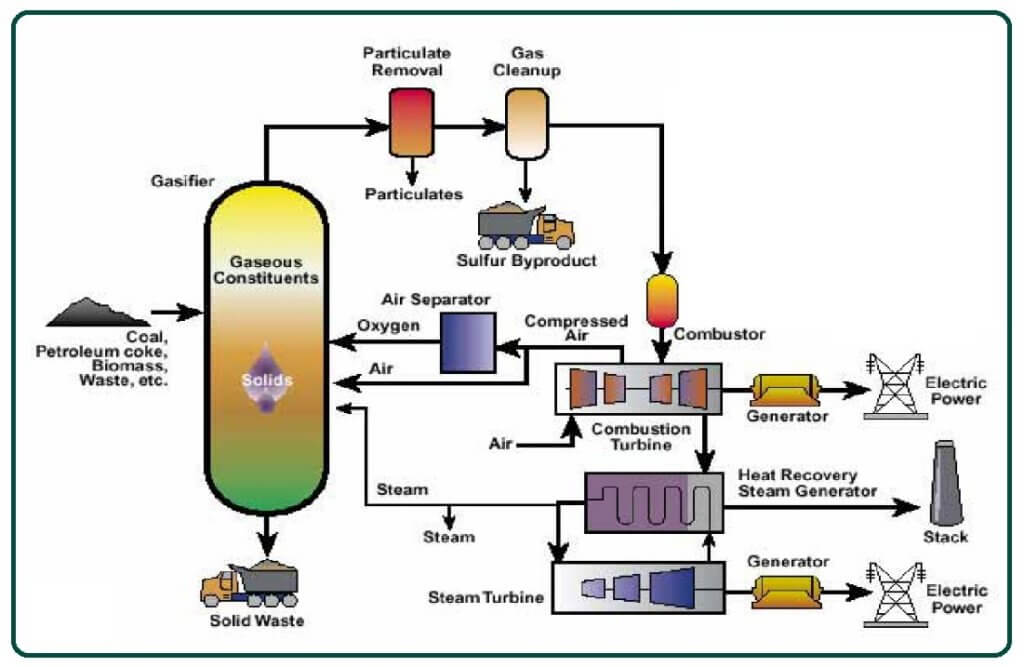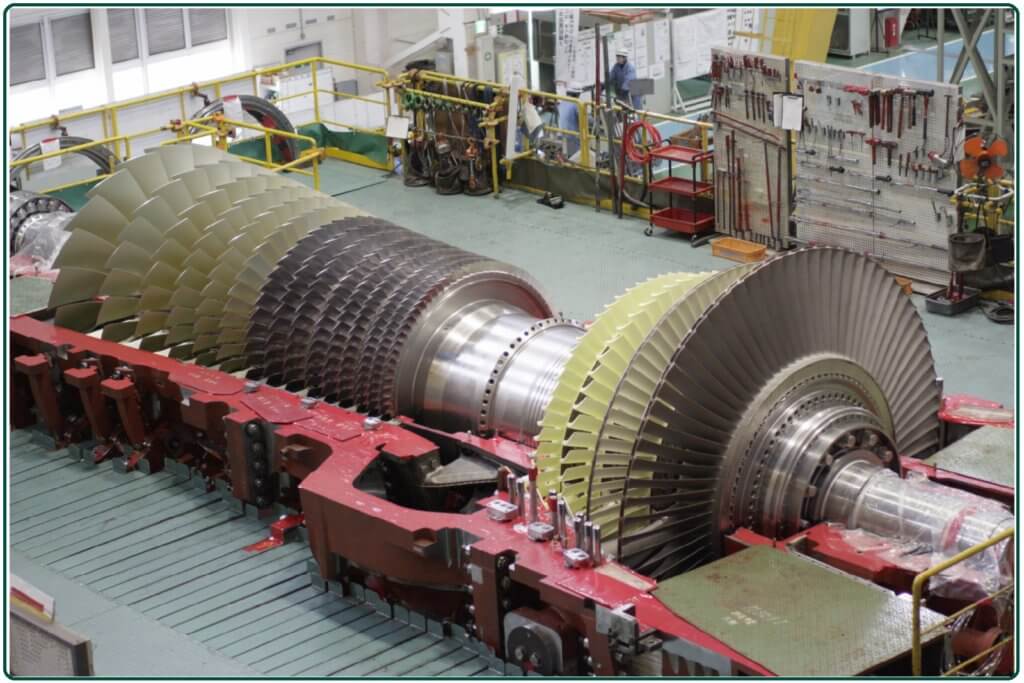
Gas Turbine Parts and Functions:
Gas Turbine Parts and Works As the hot combustion gas circulates through the turbine, it rotates the rotating blade. Rotating blades perform a dual function: they drive the compressor to draw more pressurized air into the combustion section, and they spin a generator to generate electricity.
Introduction to Gas Turbine Power Plant:
Demand for gas power plants is increasing due to some benefits. Natural gas is used as a fuel, and other fuels may be synthetic gas. Just as in steam power plants, which contain operating fluid water and steam mixtures, in gas turbine power plants, air mixtures are used as a derived fluid.
In a jet engine, there is a turbine on one side and a compressor on one side, and the air is entered into the compressor; it is mixed with fuel, ignites it, and then exits it from the turbine. Is the turbine converting pressure and velocity into electric power through a generator?
A major problem in operating gas turbine power plants is that when the fuel is being ejected, its temperature is 400–500 ° c, which can cause atmospheric pollution and waste a lot of energy.
Due to this wastage of energy, the efficiency of common gas turbine power plants and open-cycle gas turbines is around 20–25%, which is less than its capacity; even the capacity of steam turbines is more than this.
The compressor and turbine are mostly on the same shaft. The compressor drives and compresses the air 15–30 bar, and then the fuel is mixed, and when this mixture passes through the gas turbine at high pressure, the energy is converted.
The energy required to drive the compressor is channeled through the turbine from the same shaft to the compressor, meaning that the major part of the energy is used by the compressor to drive, and the remaining energy is used in the turbine.
The compressor consists of several stages, low-pressure compressor, intermediate pressure compressor, and high-pressure compressor.
The compressor is the opposite of a gas turbine. The turbine uses kinetic energy and converts it into rotational kinetic energy; however, the compressor converts it to the potential energy of the air and fuel mixture using rotational kinetic energy.
Major Parts of Gas Turbine Power Plant:

Operation of gas turbine power plant Gas Turbine.
Gas Turbine:
A gas turbine is used to converts the kinetic energy of hot gases into rotational energy, which is used to drive a synchronous generator. It has several phases, the high-pressure phase, the intermediate pressure phase, and then the low-pressure phase.
The combustion process takes place in the turbines; therefore, to protect the blade from melting, the cooling process also takes place here. Most of the time, cold fluid is continuously passing through the blade.
The Compressor of Gas Turbine Power Plant:
It is mounted on a single shaft, it compresses normal air and distributes it to the combustion chamber. It also has multiple stages, low-pressure phase, intermediate pressure phase, and then high-pressure phase to increase efficiency.
The combustion chamber of the Gas Turbine Power Plant:
compressed air is recorded here, and it is mixed with fuel. It is then ignited here, which leads to an increase in temperature and pressure.
The temperature can go up to 1400 ° c. At this very high temperature, nitrogen can combine with oxygen to produce nitrogen oxide but is controlled in such a way that all oxygen is used in the combustion process.
Auxiliaries for the Operation of Gas Turbine Power Plant:
Assistant for operating a gas turbine power plant various starting equipment, fuel systems, oil systems, lubrication pumps but they are not part of our focus.
Methods to Increase Efficiency of an Open-Cycle Gas Turbine Power Plant:
There are two techniques available to improves the efficiency of n open-cycle gas turbines power plant:
- Combined Cycle of Gas Turbine Power Plant.
- PlantIntegrated Gasification Cycle of Gas Turbine Power Plant.
#1. Combined Cycle of Gas Turbine Power Plant

- The exhaust waste is used in heat recovery steam generators. Mainly 2 turbines are used, 1 is gas turbine whose exhaust is utilized by the heat recovery steam generator and generate steam and run the steam turbine.
- So, in 1 unit, there are 2 turbines and 2 synchronous generators. Efficiency can be increased by 50–60%
#2. PlantIntegrated Gasification Cycle of Gas Turbine Power Plant

When fuel is not available, another fuel is gasified, boilers (gasifiers) are used to gasify the low-quality coal, waste material, or biomass by partial combustion. After it is gasified, the hot gases produced are CO, H2, CO2, which are used.
Thermodynamic Cycle of Gas Turbine Power Plant:

Gas turbines operate on the Breton bicycle. 25% of the world’s energy production is based on gas-turbine power plants.
This percentage will increase if energy production is reduced by the use of fossil fuels. Open-cycle efficiency can be increased up to 38%. Small-scale gas turbines can be used to obtain 35–45 MW of energy.
Open Cycle Gas Turbine Power Plant:
If the exhaust expands into the atmosphere, it is called an open-cycle gas turbine; the exhaust energy cannot be regained. 50–55% of the energy is wasted in the exhaust.
Combined Cycle Gas Power Plant-
Is a combined cycle, exhaust gases are used in steam, and their energy is reclaimed and used. Larger gas turbines have lower efficiency, but due to modern research, their efficiency increases up to 38.7% and also increases the size of their unit.
Earlier, 50 MW gas turbine units were used, but now, units up to 265 MW can be used. The efficiency of a gas turbine plant depends on the inlet and outlet temperatures of the turbine part.
The inlet temperature is around 1400–1600 ° c, and the exit temperature is about 400 ° c. So there is less efficiency due to this temperature difference.
In the future, if good quality materials are used, the temperature of the combustion chamber may be increased, thereby increasing our overall efficiency.
Energy Cycle:

- The inlet energy is due to the ambient temperature, so it is minimal.
- The compressor compresses the air 30 times; then it is mixed with the fuel and lit; therefore, the major part of the energy is from the fuel mixture.
- Compressed air energy + fuel energy is inlet energy.
- It is converted into rotational energy.
- It is converted into electrical energy.
- About 80% of the energy is wasted in open-cycle gas turbines, but if we use combined-cycle gas turbines, it can be recovered.
Choice of Fuel in Gas Turbine Power Plant:
Here, the Choice of Fuel in Gas Turbine Power Plant is as follows.
- Based on the characteristics of fuel gas, gas turbines are designed. Only then designers can guarantee the proper functioning of the turbine.
- The design of the combustion chamber is of major importance for efficiency. Similarly, temperature and pressure are also constantly monitored.
Advantages of Gas Turbine Power Plant:
Here, the applications of the Gas Turbine Power Plant are as follows.
- Their popularity has grown over time (around 90% in the USA). Now, they are used as standard prime movers for many industrial applications.
- Most efficient for converting fossil fuels into energy.
- Turbine → 35-265mw output, 38% efficiency in power.
- Small in size and no release of harmful gases.
FAQs that you can include in your article about gas turbine power plants:
What Is a Gas Turbine Power Plant?
A gas turbine power plant converts the energy from hot gases into rotational energy, which drives a generator to produce electricity. It typically uses natural gas or synthetic gas as fuel.
How Does a Gas Turbine Work?
In a gas turbine, air is compressed by a series of compressors, mixed with fuel in the combustion chamber, ignited, and then expanded through turbine blades. This process drives the turbine to generate electricity.
What Are the Main Components of a Gas Turbine Power Plant?
The main components include the compressor, combustion chamber, turbine, generator, and auxiliary systems like fuel and lubrication systems.
What Is the Efficiency of Gas Turbine Power Plants?
Open-cycle gas turbines typically have efficiencies around 20-25%, while combined-cycle plants, which utilize waste heat from the exhaust gases, can achieve efficiencies of 50-60%.
What Are the Advantages of Gas Turbine Power Plants?
Gas turbine power plants are efficient in converting fuel into electricity, compact in size, and widely used in industrial applications. They are also quick to start and have lower emissions compared to some other power generation technologies.
How Can the Efficiency of Gas Turbine Power Plants Be Improved?
Efficiency can be enhanced through technologies like combined-cycle systems, which recover waste heat, and by using advanced materials and design techniques to increase turbine inlet temperatures.
What Are the Environmental Considerations with Gas Turbine Power Plants?
While gas turbines produce lower emissions compared to coal-fired plants, they still emit nitrogen oxides (NOx) and carbon dioxide (CO2). Efforts are made to control these emissions through advanced combustion technologies and exhaust treatment systems.
What Role Does Fuel Choice Play in Gas Turbine Performance?
The performance and design of gas turbines are influenced by the type and quality of fuel used. Engineers optimize combustion chambers and turbine materials based on fuel characteristics to maximize efficiency and reliability.
What Are Some Future Trends in Gas Turbine Technology?
Future advancements may focus on increasing turbine inlet temperatures, improving materials to handle higher temperatures, and integrating gas turbines with renewable energy sources for hybrid power generation systems.
Where Are Gas Turbine Power Plants Commonly Used?
Gas turbine power plants are prevalent in industrial settings, including power generation for utilities, as well as in oil and gas industries, where they provide reliable and efficient energy for various operations.

